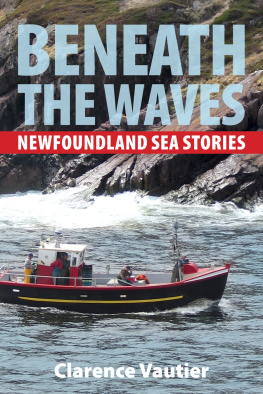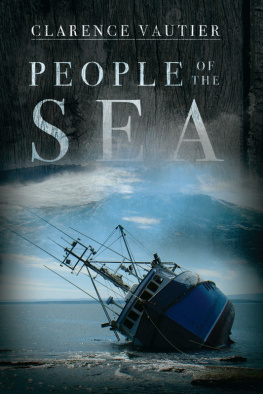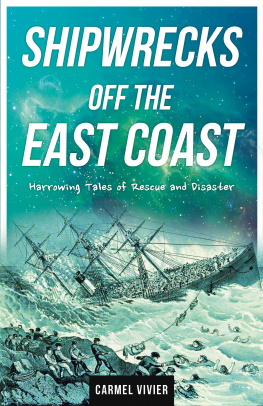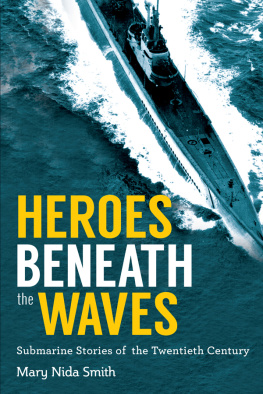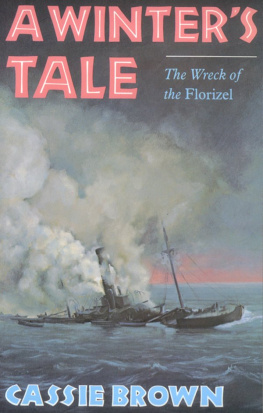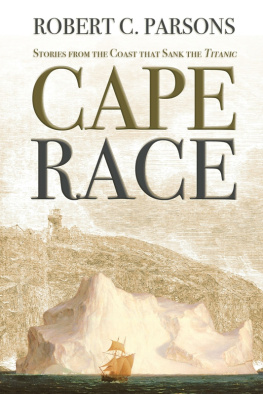
Dedication
To Brandon and Hannah, my two precious children.
Library and Archives Canada Cataloguing in Publication
Vautier, Clarence, 1972-
Beneath the waves : Newfoundland sea stories / Clarence Vautier.
Includes index.
ISBN 978-1-77117-305-6 (epub), 978-1-77117-306-3 (kindle), 978-1-77117-116-8 (pdf)
1. Seafaring life--Newfoundland and Labrador--History.
2. Shipwrecks--Newfoundland and Labrador--History. I. Title.
FC2161.8.V38 2006 971.8 C2006-902369-7
2006 by Clarence Vautier
ALL RIGHTS RESERVED. No part of the work covered by the copyright hereon may be reproduced or used in any form or by any meansgraphic, electronic or mechanicalwithout the written permission of the publisher. Any request for photocopying, recording, taping or information storage and retrieval systems of any part of this book shall be directed to Access Copyright, The Canadian Copyright Licensing Agency, 1 Yonge Street, Suite 800, Toronto, ON M5E 1E5. This applies to classroom use as well.
PRINTED IN CANADA
FLANKER PRESS
PO BOX 2522, STATION C
ST. JOHNS, NL, CANADA
TOLL FREE: 1-866-739-4420
WWW.FLANKERPRESS.COM
Cover Design by Margot Gordon
First Canadian edition printed May 2006
15 14 13 12

5 6 7 8 9 10
We acknowledge the financial support of the Government of Canada through the Book Publishing Industry Development Program (BPIDP) for our publishing activities; the Canada Council for the Arts which last year invested $24.3 million in writing and publis hing throughout Canada; the Government of Newfoundland and Labrador, Department of Tourism, Culture and Recreation.
Table of Contents
Introduction
In 2001, after countless personal interviews and painstaking research, I published a collection of short stories entitled The Coast of Newfoundland: The Southwest Corner. Since that time, Ive had the fortune of meeting and conversing with more wonderful people who were eager to share their stories and memories. These recollected pieces of the past involved shipwrecks, family tragedies, collisions at sea, and much more. As with the first compilation, I felt that these people also deserved to have their stories told.
In many situations, the records of these occurrences were limited, however people were gracious in offering documentation, photos, and whatever information they felt could be useful.
My hope is that by reading this book, some other young writers interest in local history will be stimulated, which in turn, will help preserve the history of the hardworking people of Newfoundland and Canadas east coast.
The knowledge I have gained in researching and writing these stories has been tremendous. I hope the reader will enjoy them as much as I enjoyed presenting it.
Clarence Vautier
The Mystery of the Maud Gilliam
Between the southwest point of Newfoundland at Cape Ray and the north point of Cape Breton called Cape North, there lies a stretch of open water some sixty miles wide. The area known as the Cabot Strait has been a busy shipping lane for commercial ships and fishing vessels for decades.
Although this stretch of water is only sixty miles wide, it has, over the years, claimed hundreds of lives in a variety of different ways. Many of the lives lost in this area have been from coasting schooners and fishing boats, that in some cases, have simply vanished without a trace.
In the fall of 1894, Captain Michael Gilliam of Channel, Newfoundland, prepared for another routine voyage to Cape Breton in his schooner the Maud Gilliam . The Maud Gilliam was a 76-foot schooner built in Shelburne, Nova Scotia, in 1889, and was owned by Captain Gilliam himself. Gilliam was an experienced hand in the coasting trade and had many voyages in the waters of the Cabot Strait and beyond.
On the morning of November 22, 1894, the Maud Gilliam slipped her lines and departed Channel for the 95-mile voyage to North Sydney to pick up a cargo of coal and general supplies for the local merchants around Channel. In a short while, the Maud Gilliam passed Channel Head and headed into the open water. There were also other schooners from the Channel area destined for the same port with similar cargo.
Later that night the weather began to change, with an increase in winds and sea, along with poor visibility. People back home knew that the schooners and their crews must have had an uncomfortable night, but no one really felt concerned for the fleet of schooners.
As time passed, the Maud Gilliam was the only schooner unheard from. Family members began to ask questions and wonder were the vessel was. Unfortunately there were no answers to their questions. The Maud Gilliam and her crew had simply vanished.
What could have happened to the crew and the sturdy vessel will always be a mystery, yet one still ponders the question.
The Maud Gilliam was similar to other vessels crossing the Cabot Strait from Port aux Basques that night. If the weather had overcome the vessel, why hadnt other vessels in the fleet experienced trouble as well? At the time of the incident, the vessel was still new, just five years old, and built by some of the best-known shipbuilders in Shelburne. By the time the weather had gotten bad she would have been close to the Cape Breton shores, yet there was no wreckage, survivors, or bodies found. Maybe the Maud Gilliam and her crew were involved in a collision with a large commercial ship shortly after leaving Channel, and the wreckage drifted past the remote coastline of the Channel area and into the vast waters of the Gulf of St. Lawrence.
The Maud Gilliam and her crew had joined the long list of those lost at sea. At the time of her disappearance her crew and passengers were as follows:
Michael Gilliam, 55
Philip Gilliam, 22
Keiz Carter, 50
Benjamin Gilliam, 57
John Gilliam, 22
James Sheaves, 28
Alexander Waddell, 32
Marie Gillingham, 27
The Wreck of the Fiona
Over the past century, there have been incidents involving freak waves and storms that seem to come out of nowhere. With todays technology and continuous research, most of these events are forecast ahead of time, avoiding disasters at sea and on land.
Still, this was not the case in September of 1900, when the whole continent of North America was affected by an irregular weather pattern. The week had started out fine. In the eastern portion of the Caribbean, a normal, seasonal hurricane had developed, and was slowly making its way westward. Unfortunately, before long, Hurricane Isaac gathered great strength as it made its way north.
The hurricane season in the North American quadrant of the world runs from June to November. These hurricanes develop in the warm waters of the Caribbean and travel westward until they reach the northern latitude of approximately 20. Here they turn with the effect of the prevailing westerlies and travel eastward towards the eastern seaboard of North America. Oftentimes, they pass far enough to the east so that Nova Scotia and Newfoundland avoid getting the brunt of it.
A hurricane has to have certain features to maintain its true character and one of these characteristics is that they must maintain a water temperature of twenty-five degrees celsius. Shortly after a hurricane makes contact with land, it either veers away or simply diminishes due to the fall in water temperature.
On September 8, 1900, Hurricane Isaac touched land near Texas, but continued northward towards Canada. It changed direction, but its intensity remained the same. This was unusual and on the morning of September 13, 1900, the hurricane swept over the East Coast of Canada and onward towards Newfoundland.
Next page
